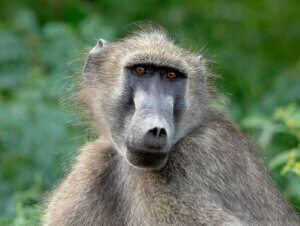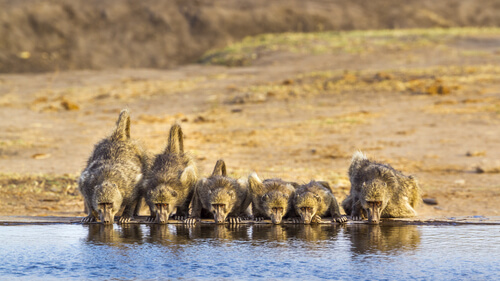7 Curious Facts About Baboons


Written and verified by the biologist Cesar Paul Gonzalez Gonzalez
Baboons are a group of primates famous for their lack of hair on their rump and face. Although it’s true that they aren’t very sociable specimens, their physical characteristics are unmistakable even among other hominids. Thanks to this and other curious facts about baboons, these mammals are very popular!
Contrary to what one might think, there are several species belonging to the genus Papio that are known as “baboons”. They’re close relatives of mandrills and talapoins, which belong to the so-called old-world monkeys. Continue reading this space and discover some curious facts about baboons.
What do baboons look like?
Baboons are medium-sized animals that measure on average between 50 and 90 centimeters (20 to 35 inches) long. They maintain the same physiology as all primates, with a broad body, slender limbs and an arched tail. However, they differ in the fact they have a longer and thinner jaw, with large canines and a strong bite.
These primates are mainly found in Africa, although there are some specimens that also inhabit the Arabian Peninsula. For this reason, their habitat includes both savannah grasslands and some arboreal areas.

Little-known facts about baboons
Baboons are known for their peculiar appearance. However, there are some curious aspects of this group that not many people know about.
1. They’re very aggressive
Although their appearance may seem harmless, baboons are characterized by aggressive and sometimes exaggerated behavior. In addition, this type of behavior intensifies during the breeding season, as several specimens even chase their aggressors if they dare to attack them.
2. They don’t have many predators
One of the most curious aspects of baboons is that their specimens have few predators. This is due to their aggressive behavior, with which they chase away most animals. In fact, only leopards, crocodiles, and lions could win a battle against these primates, but they don’t always come out unscathed.
3. They form large groups
Despite their aggressive behavior, baboons tend to form groups of between 5 and 200 individuals in total. Of course, they maintain a hierarchical structure where the strongest male leads all others. However, it’s normal for internal conflicts (fights) to reign in the community.

4. Their tail isn’t prehensile
Although baboons may have arboreal habits, they don’t have a prehensile tail to help them hold on to branches. Still, they’re very adept on trees thanks to their opposable thumbs, although they prefer to spend most of their time on the ground.
5. Their vocalizations are quite complex
Vocalizations in baboons are essential for internal group communication. In fact, the combination of various sounds (screams, grunts, or barks) and noises (lip smacking or yawning) is their language. In addition, they’re capable of inventing new combinations to describe new situations in their environment.
6. Their rump is covered by a callus
Baboons are also known to have a peculiar rump with vivid colorations (in some species). Contrary to appearances, this area is actually covered by a bulging callus that protects and cushions its weight.
7. There are 6 species of baboons
The taxonomy of baboons has changed several times over time. However, only 6 formal species are currently recognized:
- Olive baboon (Papio anubis)
- Guinean baboons (Papio papio)
- Chacma baboon (Papio ursinus)
- Kinda baboon (Papio kindae)
- Yellow baboon (Papio cynocephalus)
- Hamadryas baboon (Papio hamadryas)
As can be seen, baboons are a curious and peculiar group of animals. Although their distribution is quite restricted and you’re unlikely to have contact with them, this doesn’t detract from how majestic this species is. In fact, it could be said that they’re a clear reference point of African and Asian fauna.
Baboons are a group of primates famous for their lack of hair on their rump and face. Although it’s true that they aren’t very sociable specimens, their physical characteristics are unmistakable even among other hominids. Thanks to this and other curious facts about baboons, these mammals are very popular!
Contrary to what one might think, there are several species belonging to the genus Papio that are known as “baboons”. They’re close relatives of mandrills and talapoins, which belong to the so-called old-world monkeys. Continue reading this space and discover some curious facts about baboons.
What do baboons look like?
Baboons are medium-sized animals that measure on average between 50 and 90 centimeters (20 to 35 inches) long. They maintain the same physiology as all primates, with a broad body, slender limbs and an arched tail. However, they differ in the fact they have a longer and thinner jaw, with large canines and a strong bite.
These primates are mainly found in Africa, although there are some specimens that also inhabit the Arabian Peninsula. For this reason, their habitat includes both savannah grasslands and some arboreal areas.

Little-known facts about baboons
Baboons are known for their peculiar appearance. However, there are some curious aspects of this group that not many people know about.
1. They’re very aggressive
Although their appearance may seem harmless, baboons are characterized by aggressive and sometimes exaggerated behavior. In addition, this type of behavior intensifies during the breeding season, as several specimens even chase their aggressors if they dare to attack them.
2. They don’t have many predators
One of the most curious aspects of baboons is that their specimens have few predators. This is due to their aggressive behavior, with which they chase away most animals. In fact, only leopards, crocodiles, and lions could win a battle against these primates, but they don’t always come out unscathed.
3. They form large groups
Despite their aggressive behavior, baboons tend to form groups of between 5 and 200 individuals in total. Of course, they maintain a hierarchical structure where the strongest male leads all others. However, it’s normal for internal conflicts (fights) to reign in the community.

4. Their tail isn’t prehensile
Although baboons may have arboreal habits, they don’t have a prehensile tail to help them hold on to branches. Still, they’re very adept on trees thanks to their opposable thumbs, although they prefer to spend most of their time on the ground.
5. Their vocalizations are quite complex
Vocalizations in baboons are essential for internal group communication. In fact, the combination of various sounds (screams, grunts, or barks) and noises (lip smacking or yawning) is their language. In addition, they’re capable of inventing new combinations to describe new situations in their environment.
6. Their rump is covered by a callus
Baboons are also known to have a peculiar rump with vivid colorations (in some species). Contrary to appearances, this area is actually covered by a bulging callus that protects and cushions its weight.
7. There are 6 species of baboons
The taxonomy of baboons has changed several times over time. However, only 6 formal species are currently recognized:
- Olive baboon (Papio anubis)
- Guinean baboons (Papio papio)
- Chacma baboon (Papio ursinus)
- Kinda baboon (Papio kindae)
- Yellow baboon (Papio cynocephalus)
- Hamadryas baboon (Papio hamadryas)
As can be seen, baboons are a curious and peculiar group of animals. Although their distribution is quite restricted and you’re unlikely to have contact with them, this doesn’t detract from how majestic this species is. In fact, it could be said that they’re a clear reference point of African and Asian fauna.
All cited sources were thoroughly reviewed by our team to ensure their quality, reliability, currency, and validity. The bibliography of this article was considered reliable and of academic or scientific accuracy.
- Fuchs, A. J., Gilbert, C. C., & Kamilar, J. M. (2018). Ecological niche modeling of the genus Papio. American Journal of Physical Anthropology, 166(4), 812-823.
- Anderson, J. R., & McGrew, W. C. (1984). Guinea baboons (Papio papio) at a sleeping site. American Journal of Primatology, 6(1), 1-14.
- Kemp, C., Rey, A., Legou, T., Boë, L. J., Berthommier, F., Becker, Y., & Fagot, J. (2017). Vocal repertoire of captive Guinea baboons (Papio papio). Origins of human language: Continuities and discontinuities with nonhuman primates, 15.
- Boë, L. J., Berthommier, F., Legou, T., Captier, G., Kemp, C., Sawallis, T. R., … & Fagot, J. (2017). Evidence of a vocalic proto-system in the baboon (Papio papio) suggests pre-hominin speech precursors. PloS one, 12(1), e0169321.
- Owren, M. J., Seyfarth, R. M., & Cheney, D. L. (1997). The acoustic features of vowel-like grunt calls in chacma baboons (Papio cyncephalus ursinus): Implications for production processes and functions. The Journal of the Acoustical Society of America, 101(5), 2951-2963.
- Ennaji, F. E., Fagot, J., & Belin, P. (2022). Categorization of vocal and nonvocal stimuli in Guinea baboons (Papio papio). American Journal of Primatology, e23387.
This text is provided for informational purposes only and does not replace consultation with a professional. If in doubt, consult your specialist.








